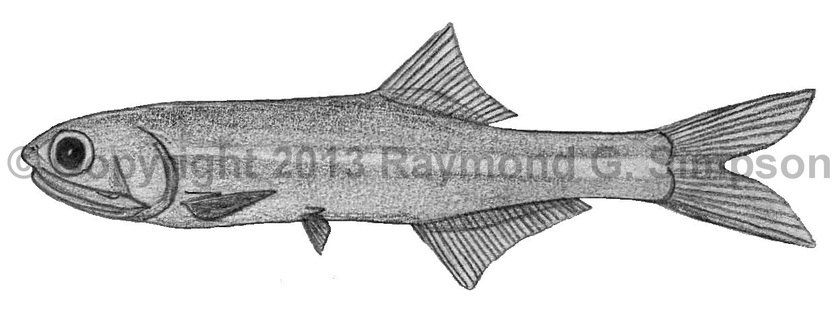
Common Name
Little Anchovy
Year Described
Meek & Hildebrand, 1923
Identification
Dorsal Fin: 13-16
Anal Fin: 20-25
Pectoral Fin: 12-13
Gill Rakers: 18-20 upper, 23-27 lower
Vertebrae: 38-41
Lateral Line Scales: 38-42
Body elongate and laterally compressed. Body depth 20-22% TL. Snout conical and about half eye diameter in length. Mouth very large and inferior. Maxilla tip extends well over preoperculum (to beyond edge). Teeth small. Suborbital bone slightly longer than eye diameter. Pseudobranch shorter than eye diameter (does not reach onto operculum). Dorsal fin origin a little past midpoint of body with a concave rear margin. Pectoral fin long, low and falls well short of pelvic fin base (<eye diameter). Pelvic fin equally distant from pectoral and anal fin. Pelvic fin with seven rays. Anal fin origin under middle of dorsal fin. Caudal fin forked. Anus closer to pelvic fin base than anal fin origin. Scales cycloid and deciduous. Lateral line absent.
Color
Body translucent. Side with a wide (about 3/4 eye diameter) silvery stripe that does not narrow significantly. Black speckles along fin bases. Fins clear.
Size
Maximum size to 90mm TL.
Habitat
A coastal species found in both brackish and marine waters. Schooling.
Range
Northern Yucatan Peninsula to Venezuela and Cuba to the Lesser Antilles.
References
Hildebrand, S.F. 1964. Engraulidae and Clupeidae (pp. 152-454). In: Fishes of the Western North Atlantic. Mem. Sears Fnd. Mar. Res. 1 (Vol. 3): 1-630.
McEachran, J.D. & J.D. Fechhelm. 1998. Fishes of the Gulf of Mexico. Volume 1: Myxiniformes to Gasterosteiformes. University of Texas Press, Austin. i-viii + 1-1112.